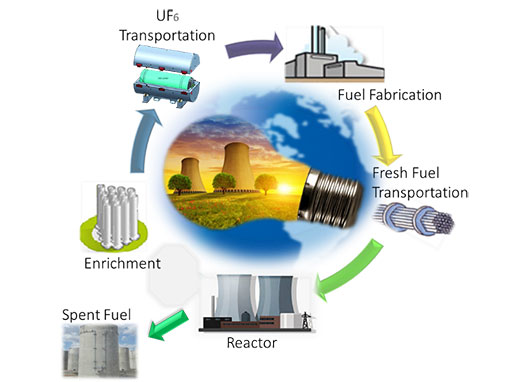Fuel Cycle, Transportation, and Storage
On this page:

For many decades, commercial power reactor fuels have consisted of uranium dioxide (UO2) pellets encapsulated by zirconium (Zr)-alloy cladding. The enrichment of commercial power reactor fuel has historically been less than or equal to 5 weight percent uranium-235 (U-235). Accident Tolerant Fuels (ATF) may contain different types of fuel (meaning not UO2), enrichment greater than 5 weight percent U-235, and different claddings (e.g. chromium coated cladding), all of which may have an impact on the enrichment and fabrication process, transportation of a fresh fuel assembly, and transport and storage of irradiated material.
Regulatory Requirements
The NRC regulates fuel cycle activities for fuel fabrication, radioactive material transportation, and spent fuel storage under Title 10 of the Code of Federal Regulations (CFR) Part 70, 10 CFR Part 71, and 10 CFR Part 72, respectively. These regulations identify general performance requirements and have been used for licensing and certifying a broad spectrum of enrichment and fuel fabrication facilities, transportation packages, and storage systems (excluding the spent fuel pool at nuclear power plants). The NRC does not expect these regulations to need modification to accommodate the enrichment, fabrication, transportation, or storage of ATF. Therefore, the licensing and certification of ATF is expected to follow the same licensing process for fuel cycle facilities, transportation, and storage that is used for the enrichment, fabrication, transportation, and storage of conventional commercial reactor fuel (i.e., UO2).
However, given the nuclear industry's desire to deploy ATF with increased enrichment and higher burnup, there may be some impacts to the operations of the nuclear fuel cycle. These impacts affect fuel enrichment, fuel fabrication, transportation of greater than 5 weight percent uranium-235 (U-235) uranium hexafluoride (UF6) or other feed material, transportation of fresh fuel, and transportation and storage of irradiated material with higher burnup.
Additional Information
For more detailed information on Fuel Cycle, Transportation, and Storage, please see the following pages:
Licensing of Fuel Enrichment and Fabrication Facilities
Certification of Packages for Transportation of Unirradiated Material
Certification of Packages for Transportation of Irradiated Material Transportation and Storage
Page Last Reviewed/Updated Thursday, June 13, 2024
Page Last Reviewed/Updated Thursday, June 13, 2024

